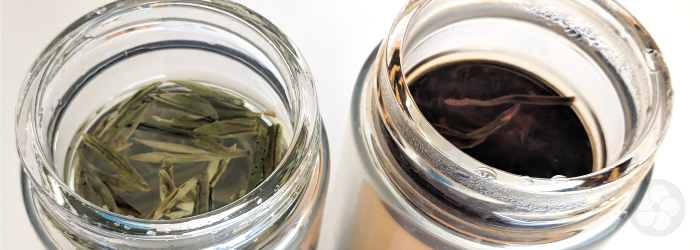4 Ways to Use a Tea Thermos

Thermoses designed for brewing tea are becoming more popular around the world, but the brewing techniques we use at home don’t always translate easily to these portable vessels. Practices like controlling steeping time and temperature or brewing multiple infusions may seem to rely on the availability of specialized teaware, but these four methods of using a travel thermos will show how easy it can be to adapt and make a great cup of tea - whether you’re on the go or at your desk.
Find an overview of all the ways you can brew looseleaf tea >>
1. Contain Leaves in an Infuser Basket
Many thermos gadgets designed for tea (like our double-walled glass version) include a large basket to contain the tea leaves, meant to be used in the same way as any infuser basket in a pot or mug. A large basket that gives the leaves room to open and expand can easily hold brewing leaves, and be extracted from the water to halt the brewing process. For brewing in a single location, this can work well as a portable, leak-proof infuser.
However, not all travel tea infusers are made with such a large basket. In many Chinese designs, for instance, the filter is very shallow, with the base at or above the water line. This style is intended to hold the leaves away from the opening, rather than containing them for extraction. In practice, this makes drinking on-the-go easier, since the filter holds leaves back and prevents them from getting into your mouth. In fact, despite the large basket in our own travel thermos, we often brew forgiving teas this way by placing the leaves beneath the infuser. But it also makes it more difficult to control brewing parameters.
Learn about the pros and cons of other infuser styles >>
2. Brew ‘Grandpa Style’
Brewing without paying much attention to time and temperature is actually fairly common in China, where most tea drinkers prefer their tea on the strong side anyway. The practice of letting tea leaves float unrestricted in the bottom of a mug has been dubbed ‘Grandpa Style’ for its particular popularity among elderly men, but this no-fuss brewing method is widespread among all age groups. As hydrated leaves fall to the bottom of the mug or thermos, the brew is sipped from the top, and then refilled with more hot water when the water level gets low or the flavor gets too strong.
Watch Alice demonstrate this technique with a tea bowl:
To reduce bitterness and astringency, it’s important to use high quality tea leaves when brewing this way. While a chopped leaf black tea grown near the equator would probably not taste very good when brewed for such a long time, an early spring harvest from a high elevation farm will remain flavorful no matter how long the infusion. In addition, we typically use less dry leaf than we would for the more controlled process of gong fu cha. The lower concentration of flavor allows for fewer infusions, but avoids overwhelming the palate. If we expect to sip slowly during a long commute, we might also reduce the water temperature to create a sweeter brew.
Learn how to balance temperature and steeping time to perfect each cup >>
3. Cold Brew to Grab & Go
With either an infuser basket or a shallow filter, a thermos can be a perfect tool for making cold-brewed iced tea. Leave a cold steep in the fridge overnight to have a naturally sweet and flavorful iced tea prepared for a morning commute, or refill a thermos with cold water at the office and let brew until the afternoon to ensure every drop of flavor is extracted from your tea leaves. In the fridge, a cold infusion will usually take 5-8 hours to reach full strength, but a room-temperature steep can be ready in as little as 3-4 hours.
Without hot water to quickly extract the bitter and astringent molecules from the tea leaves, this method will produce foolproof flavor from almost any tea. We love using this technique during the warm summer months to produce bright, refreshing brews that never require added sugar.
Find out how cold brewing changes tea flavor >>
4. Decant Into a Mug
For an approximation of gong fu brewing with minimal equipment, place tea leaves beneath the filter and simply decant into a large mug. Rather than leaving tea leaves to become over-brewed and bitter while drinking, this effectively separates all water from the leaves. With more control over the steeping parameters, high quality leaves will yield several infusions this way. For those teas that require specific brewing constraints, this is the best way to yield familiar flavor.
Though this is similar to the process of removing a large infuser basket, it will work equally well with a shallow filter, and also serves to contain the wet leaves while they are separated from the brew. It also works in both semi-permanent conditions, like at a work desk where ceramic mugs are available, or with a paper to-go cup while on the move. Just be careful while pouring!
What is your favorite way to use a travel tea thermos? Let us know in the comments below!
Sign up for our newsletter to get blog updates in your inbox!






Comments on this post (0)